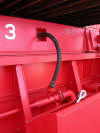13 Dec 2003 - Seventh day at sea - now in the Southern Hemisphere

0710 - We're at 2.20S, 150.19W.
1230 - working steadily on programming. Took a walk up to the bow and back but I'm being cautious today. I got a mild sunburn on my bare white legs yesterday sitting up at the bow for 30-40 minutes. Today, it is long pants for me. It is hotter outside today as well. The sky is almost cloudless. The sea is as it has been for almost the entire trip. It is stirred up just enough to cause a few whitecaps.
We've got a lifeboat / fire drill this afternoon at 1520. I've tried on my life jacket so I know how to put it on. And I know where the assembly station is so I think I'm ready.
1630 - An interesting last hour. The ships' crew held a lifeboat and a fire drill. The first was mandatory for us while the second was optional. I stayed, as did John, for both features.


We discussed boarding the lifeboat. You get in and take off your life vest and stow it (he said it is obvious where) and then take a seat and fasten the seatbelt. The boats can each carry 30 people and we have 24 on the ship so in a real emergency, we'd probably just launch one.
Then he took us over to the inflatable life rafts.



Both the life boats and the life rafts have emergency signal beacons on them. There's another big one atop the bridge which, if no one can get to it to take it because the ship sinks too quickly, will float off of its own accord and self-activate. The small rings which can be thrown overboard also have signal buoys attached to them.
The other thing Emil told us is that if we have time, we should bring warm clothes. Especially if the ship is in northern or southern waters. And, identity papers.




That was it. They finished up and John and I took off. It was hot out there on the starboard side where the sun is shining.
I'd dressed in a dark blue long-sleeve tee-shirt and levis so if I got dirty, it wouldn't be so bad. Now that I'm back, I've opened the cabin's port hole and stripped down to swimming trunks.
John told me more about himself today. He's always lived in Santa
Barbara except for his service years ('57 to '60) in the Navy. He went to
college and ended up teaching High School.

When he taught school, it was mostly English so that helps explain why he's so widely read. He never married, never had any kids. He likes to go up to Idaho in the summer and he's apparently got one or two properties up there as well.
He's a quiet kind of a guy. Always takes a good long moment to chew over anything you say to him and is thoughtful with his response. He seems ready and able to discuss just about any topic so we've had some good talks. I have the feeling, though, that he can probably overdose on people pretty quickly. He looks like he's pretty comfortable spending time with himself.
1700 - well after a burst of web site writing, I'm ready to continue programming. Just as it was coffee time, I created a "first-chance exception" error in GENA. That's usually a pretty good indicator that I've hosed something up badly with my last set of changes. Ah well, that's what they pay me nothing for.
1900 Just back from dinner. It is getting more interesting each evening to talk with Anatoly. Tonight we talked about mutual funds and retirement and stuff like that. It sounds pretty pedestrian but it gains a lot when you are seeing it all from the point of view of a Polish sailor who's now a member of the European Union. He said, for instance, that as a single man, he can live for $400 dollars a month in a village. But, I think he'll do quite well. he's been saving and investing for years and he's a smart guy.
We made an appointment to see the engine room. Anatoly's going to show us around after afternoon coffee on Monday.
Took a GPS fix a few minutes ago. The late remains of a sunset were still in evidence and Venus was burning like a diamond in the western sky. I've missed a lot of sunsets on this trip because dinner always falls around sunset.
At 1848 we're at 5.12S, 158.29W. We're in among the islands of the nation of Kiribati. The closest of which is over 100 miles away.
2340 - Time for bed. I just went up on top over the bridge. Beautiful and all of it is mine to look at. 24 people on board and no one else for many many miles and I think I was the only one to see the beauty that existed just then.
At 2335, we were at 6.19S, 153.20W.
